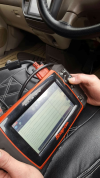UPDATE: SOLVED
I've been meaning to update ya'll on what actually happened. And thankfully it was a clear Ah-HA moment.
As described above, I proceeded to pull off the intake manifold and change the plugs/wires.
Put it all back together... No difference. So it was not some random massive IGN ground/fault loop as the cause.
I did tighten some loose valve cover bolts while I was at it though.
The remaining conclusion was that, although I was getting what seemed proper signals from the crank position sensor with hand-cranking, perhaps it was sending erratic inconsistent signals when getting triggered rapidly. Besides, it was the one sensor I hadn't swapped out yet. And then I did a test of my own... I plugged in a spare crank position sensor (leaving the installed one disconnected), and got my wife to crank the engine while I triggered the new sensor randomly with a piece of sheet-metal. I was able to reproduce the problem, some labored cranking moments and slight combustion hints. This gave me the confidence that I was on the right track. Perhaps the sensor had broken off somehow and was out of position?
So I proceeded to pull off top two coolant hoses, rad shroud and viscous-coupling fan, to get at the main pulley.
Well, things got funny already right at this point. I used the blip-the-starter method with a braced breaker bar to loosen the main bolt. It came loose no problem, but as I am wrenching it it feels funny, and suddenly comes out early... with its tip 1/2" missing (broken off). Because the sheared surface was discolored, I'm not sure it was I who just broke it. Well, I steady myself with a beer and proceed to tackle drilling out and extracting the tip. The beer helped because the tip was not seized at all, spun out immediately with the drill bit in reverse. LUCKY.
So this brings me to my first little rant about the main pulley bolt; terrible design. "Nice Try" engineering. Brutal. That long unthreaded extension section creates a long lever with the fulcrum located in the thread section. It is why Mitsubishi updated that bolt with a normal bolt later.
This broken bolt could be the cause of the issue, because of how the rest of the items on the crankshaft are designed. If the bolt manages to loosen (and that long disastrous bolt extension will also make it prone to vibrating loose btw) it will allow the timing gear to slide forward enough and the sensing plate located in behind it to shear off the tiny pins holding it in place.
So I pulled off the accessory tray and everything from the front of the engine, to get at the timing gear, sensor, and sensing plate.
So that's it. The tiny pins protruding from the back of the timing gear were sheared off, allowing the sensing plate to spin out of position, and create the way-off timing. The cranks position sensor itself was fine.
The shifted timing creates partial combustion at wrong moments, making the engine very hard to turn over. Repeated attempts strained the starter and killed it.
Since it's the first time I have touched the main crank bolt (besides turning the engine over by hand in clockwise direction), it was a previous owner/mechanic cause or neglect. I mean, the cause of the timing issue was the loose main crank bolt... which I suppose I could have coincidentally also broken off the tip 1/2"... without it being seized...
but I suspect it was related. Who knows.
I had a chat with Rocky Mountain Imports in Saanichton/Victoria, and they confirmed that they have also seen these broken pins on the timing gear, if the main pulley bolt comes loose.
But because the only thing at the wrong time was the spark, no internal engine damage is possible with this scenario. I tested my backup ECU as well just to confirm its operation, and it was perfect.
Then promptly did an oil flush and change, new filter; there was a lot of fuel in the oil from unrequited air-fuel-spark cranking and washing the rings.
For the record, engineering-wise I am not a fan of the whole arrangement on the crank nose; the one key keeps the timing gear in place, the sensing plate in behind is kept in place with tiny pins off the back of the timing gear, the main pulley is kept in place with one pin off the front of the timing gear, and then the whole mess is finished off with a terrible bolt design and then "fixed'' with an ungodly torque requirement. What could possibly go wrong?
The initial alternator dying issue was unrelated, as was the washing of the van. Just bad luck that happened nearly at the same time. The reason the van wouldn't start, then started and ran for two days, then refused to start again is because the sensing plate spun out of position once, probably temporarily caught back in position on the remaining nubs of the pins from the timing gear, then sheared them off for good.
Thanks all for reading/helping!



